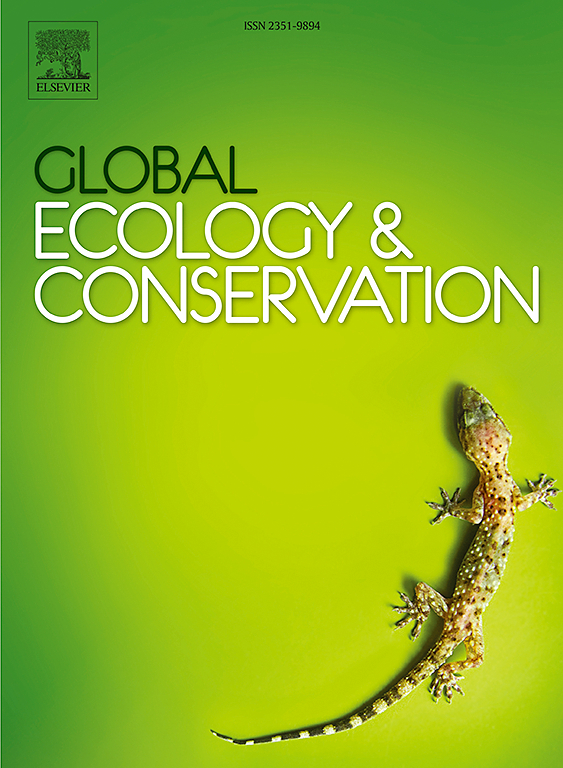Hide and seek in time and space: Spatiotemporal segregation between snow leopard and its prey in Northern Pakistan
IF 3.5
2区 环境科学与生态学
Q1 BIODIVERSITY CONSERVATION
引用次数: 0
Abstract
Temporal niche-partitioning is a key strategy for prey to avoid predators and for predators to successfully coexist sympatrically. However, little is known about the temporal and spatial dynamics of snow leopards with key prey species. We investigated the spring daily activity patterns and spatial density distributions of snow leopard (Panthera uncia), Himalayan ibex (Capra ibex sibirica), and domestic yak (Bos grunniens) to unravel the spatiotemporal behavior within their shared alpine habitat in Northern Pakistan using trail cameras data. The results indicated that snow leopards exhibited a bimodal activity pattern, with peaks around midnight and dawn. In contrast, the ibex displayed a predominantly diurnal pattern, starting at dawn and minimally overlapping with the snow leopard. Attended yaks showed a uniform diurnal activity pattern under human protection, while unattended yaks exhibited irregular activity across day and night, suggesting higher vulnerability to predation. Spatial density analysis revealed notable overlaps between species pairs, particularly unattended yaks and snow leopards, highlighting the influence of spatial dynamics on predator-prey interactions. The clear off-phased and contrasting pattern of activity between snow leopard and ibex in our study showed temporal partitioning in spring and indicates that unattended yak may be a more heavily predated species than previously thought. This study provides the first comparative analysis of temporal activity patterns between a key predator and wild and domestic prey in Northern Pakistan. This research broadens our understanding of animal behavior through the lens of spatiotemporal interactions and provides insights into the complex dynamics between predator and prey in the challenging alpine landscape. Our findings emphasize the importance of livestock guarding to mitigate depredation and highlight the complexities of predator-prey interactions in both time and space, along with the resulting behavioral adaptations.
时空捉迷藏:巴基斯坦北部雪豹和猎物之间的时空隔离
时间生态位划分是猎物躲避捕食者和捕食者成功共生的关键策略。然而,人们对雪豹捕食主要猎物的时空动态知之甚少。利用野外摄像机数据,研究了雪豹(Panthera uncia)、喜马拉雅野山羊(Capra ibex sibirica)和国内牦牛(Bos grunniens)的春季日常活动模式和空间密度分布,以揭示它们在巴基斯坦北部共同的高山栖息地内的时空行为。结果表明,雪豹的活动呈现双峰模式,活动高峰出现在午夜和黎明。相比之下,ibex表现出明显的昼夜模式,从黎明开始,与雪豹的重叠最少。在人类保护下,有看护的牦牛表现出统一的昼夜活动模式,而无看护的牦牛表现出不规律的昼夜活动模式,表明其更容易被捕食。空间密度分析显示,物种对之间存在明显的重叠,特别是无人照看的牦牛和雪豹,这突出了空间动态对捕食者-猎物相互作用的影响。在我们的研究中,雪豹和野山羊之间明显的非阶段性和对比性活动模式表明了春季的时间划分,这表明无人看管的牦牛可能比以前认为的更早出现。这项研究首次对巴基斯坦北部主要捕食者与野生和家养猎物之间的时间活动模式进行了比较分析。这项研究通过时空相互作用拓宽了我们对动物行为的理解,并提供了对具有挑战性的高山景观中捕食者和猎物之间复杂动态的见解。我们的研究结果强调了保护牲畜对减轻捕食的重要性,并强调了捕食者-猎物相互作用在时间和空间上的复杂性,以及由此产生的行为适应。
本文章由计算机程序翻译,如有差异,请以英文原文为准。
求助全文
约1分钟内获得全文
求助全文
来源期刊

Global Ecology and Conservation
Agricultural and Biological Sciences-Ecology, Evolution, Behavior and Systematics
CiteScore
8.10
自引率
5.00%
发文量
346
审稿时长
83 days
期刊介绍:
Global Ecology and Conservation is a peer-reviewed, open-access journal covering all sub-disciplines of ecological and conservation science: from theory to practice, from molecules to ecosystems, from regional to global. The fields covered include: organismal, population, community, and ecosystem ecology; physiological, evolutionary, and behavioral ecology; and conservation science.
 求助内容:
求助内容: 应助结果提醒方式:
应助结果提醒方式:


